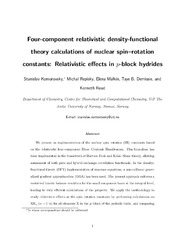Four-Component Relativistic Density-Functional Theory Calculations of Nuclear Spin-Rotation Constants: Relativistic Effects in p-Block Hydrides
Permanent link
https://hdl.handle.net/10037/8736Date
2015-07-01Type
Journal articleTidsskriftartikkel
Peer reviewed
Abstract
We present an implementation of the nuclear spin–rotation (SR) constants based on the relativistic four-component Dirac–Coulomb Hamiltonian. This formalism has been implemented in the framework of the Hartree–Fock and Kohn–Sham theory, allowing assessment of both pure and hybrid exchange–correlation functionals. In the density-functional theory (DFT) implementation of the response equations, a noncollinear generalized gradient approximation (GGA) has been used. The present approach enforces a restricted kinetic balance condition for the small-component basis at the integral level, leading to very efficient calculations of the property. We apply the methodology to study relativistic effects on the spin–rotation constants by performing calculations on XHn (n = 1–4) for all elements X in the p-block of the periodic table and comparing the effects of relativity on the nuclear SR tensors to that observed for the nuclear magnetic shielding tensors. Correlation effects as described by the density-functional theory are shown to be significant for the spin–rotation constants, whereas the differences between the use of GGA and hybrid density functionals are much smaller. Our calculated relativistic spin–rotation constants at the DFT level of theory are only in fair agreement with available experimental data. It is shown that the scaling of the relativistic effects for the spin–rotation constants (varying between Z3.8 and Z4.5) is as strong as for the chemical shieldings but with a much smaller prefactor.
Description
Accepted manuscript version. Published version at http://doi.org/10.1021/acs.jctc.5b00276.


 English
English norsk
norsk